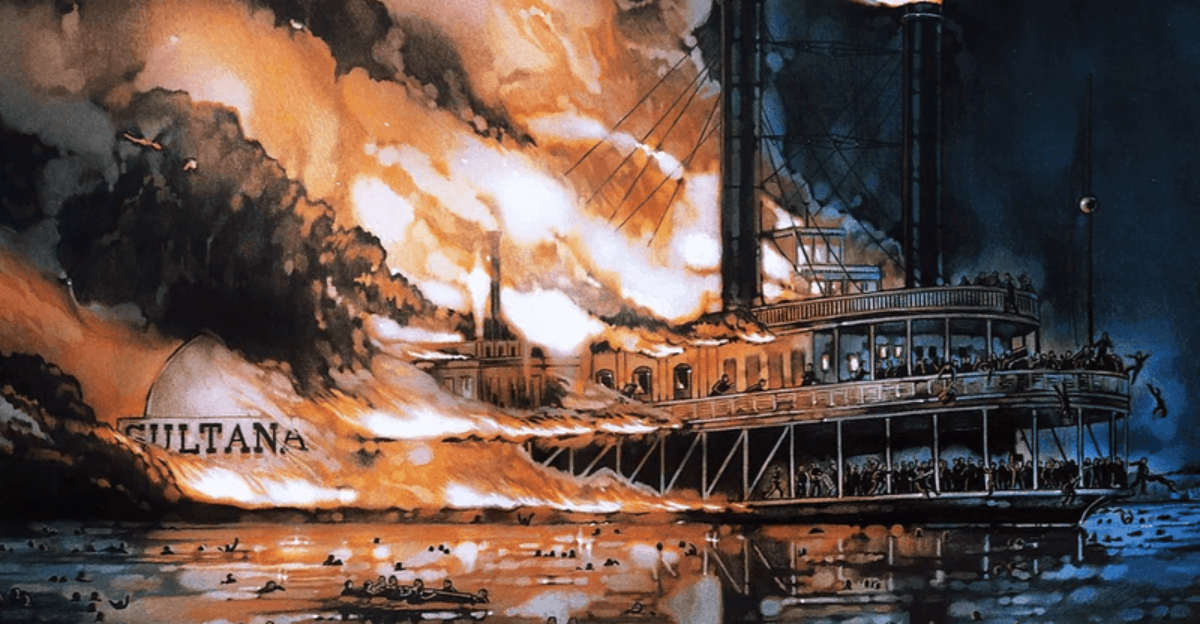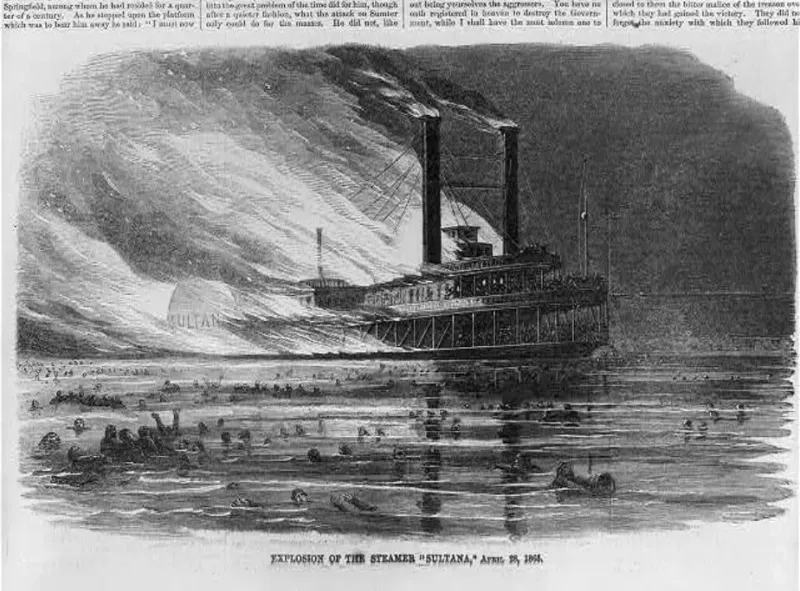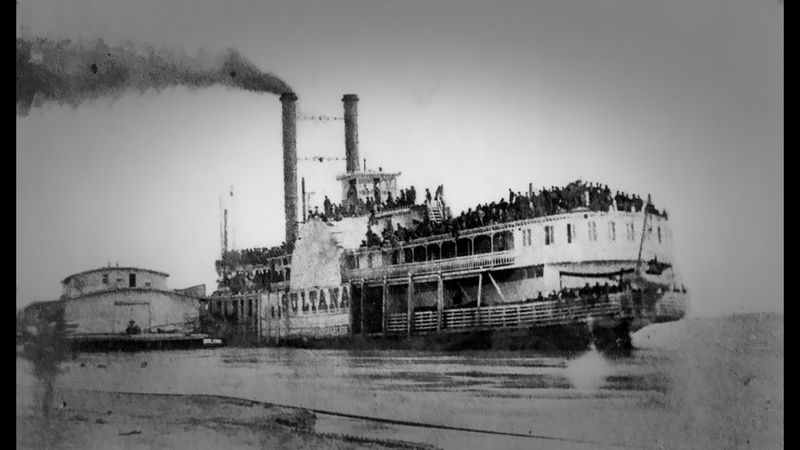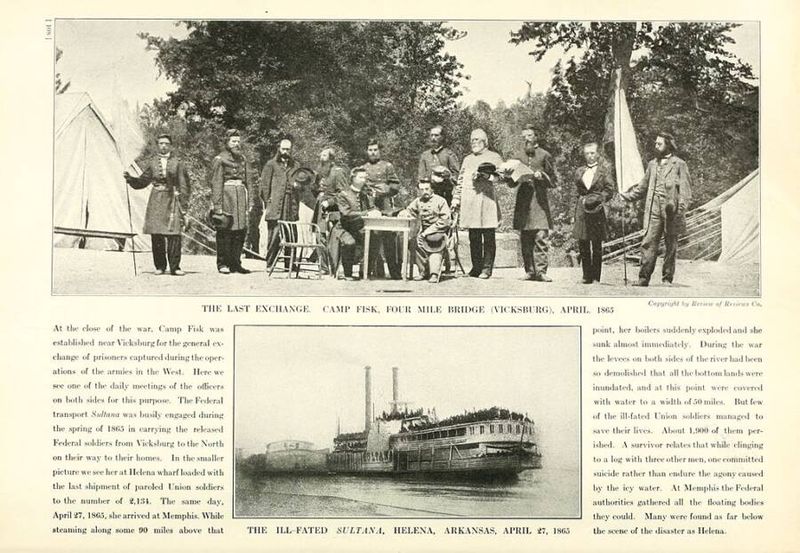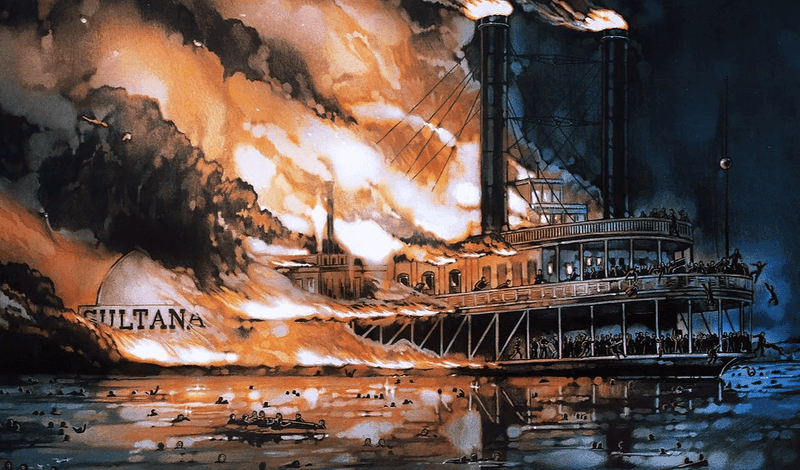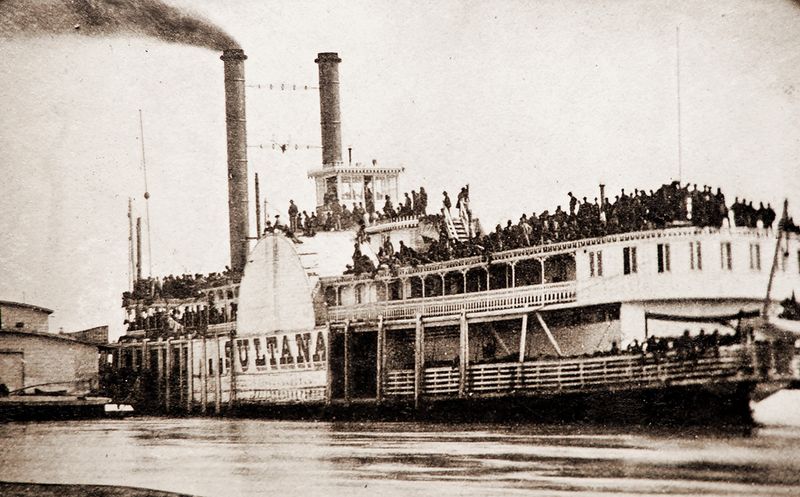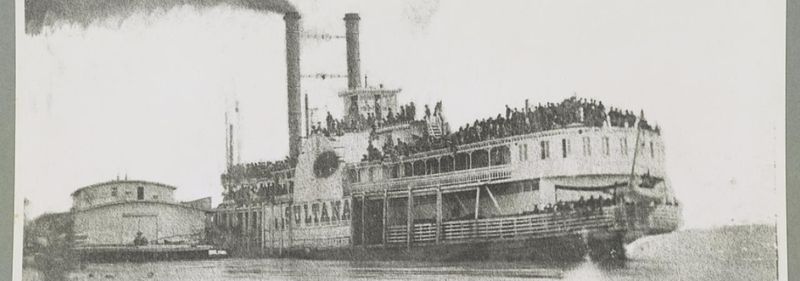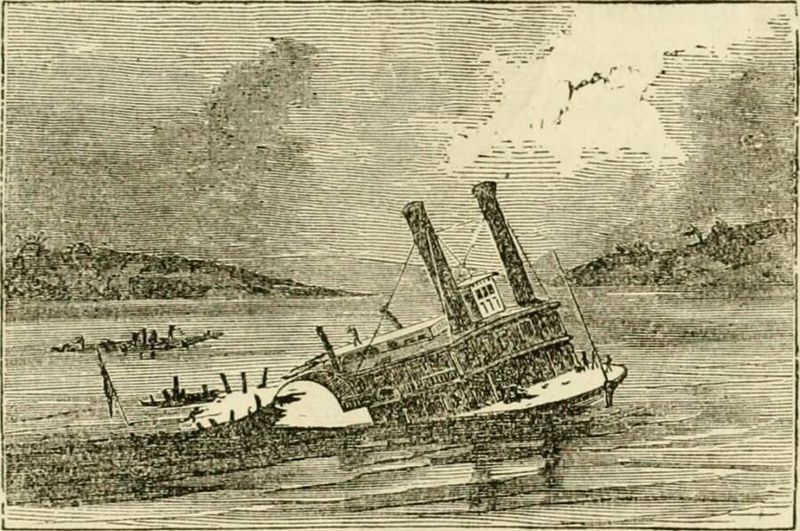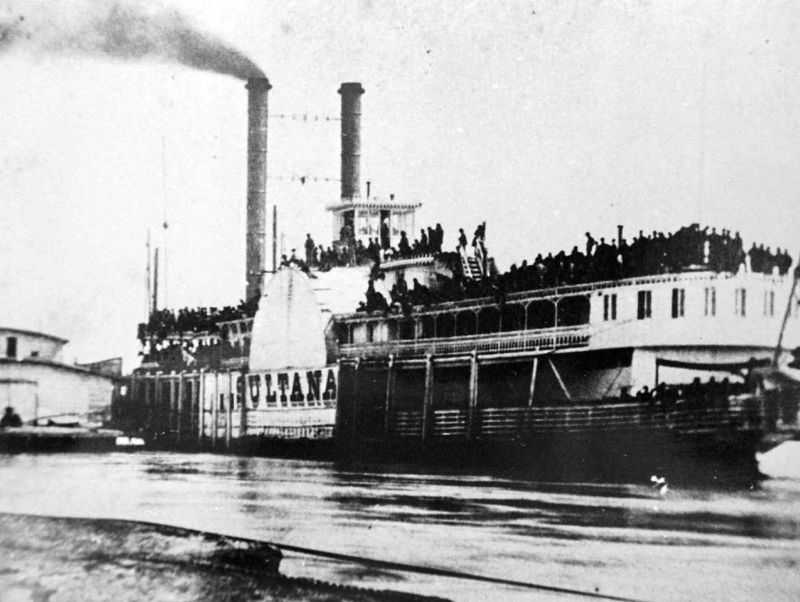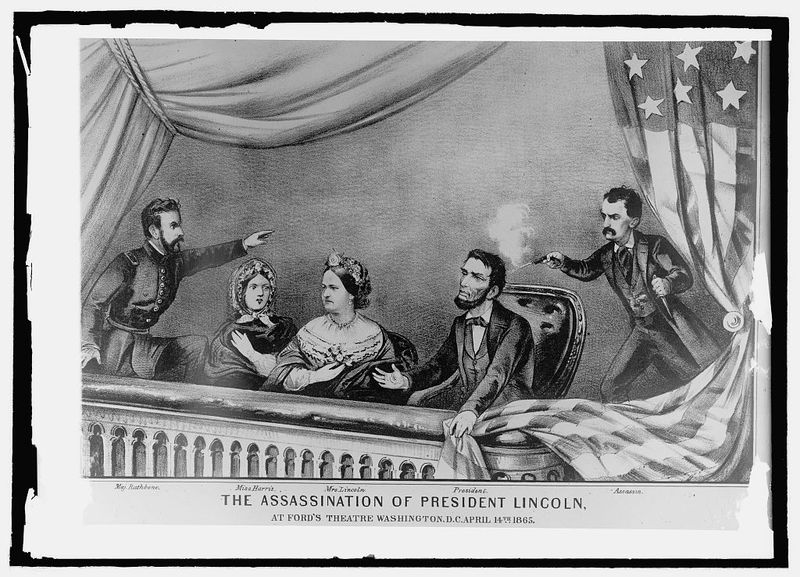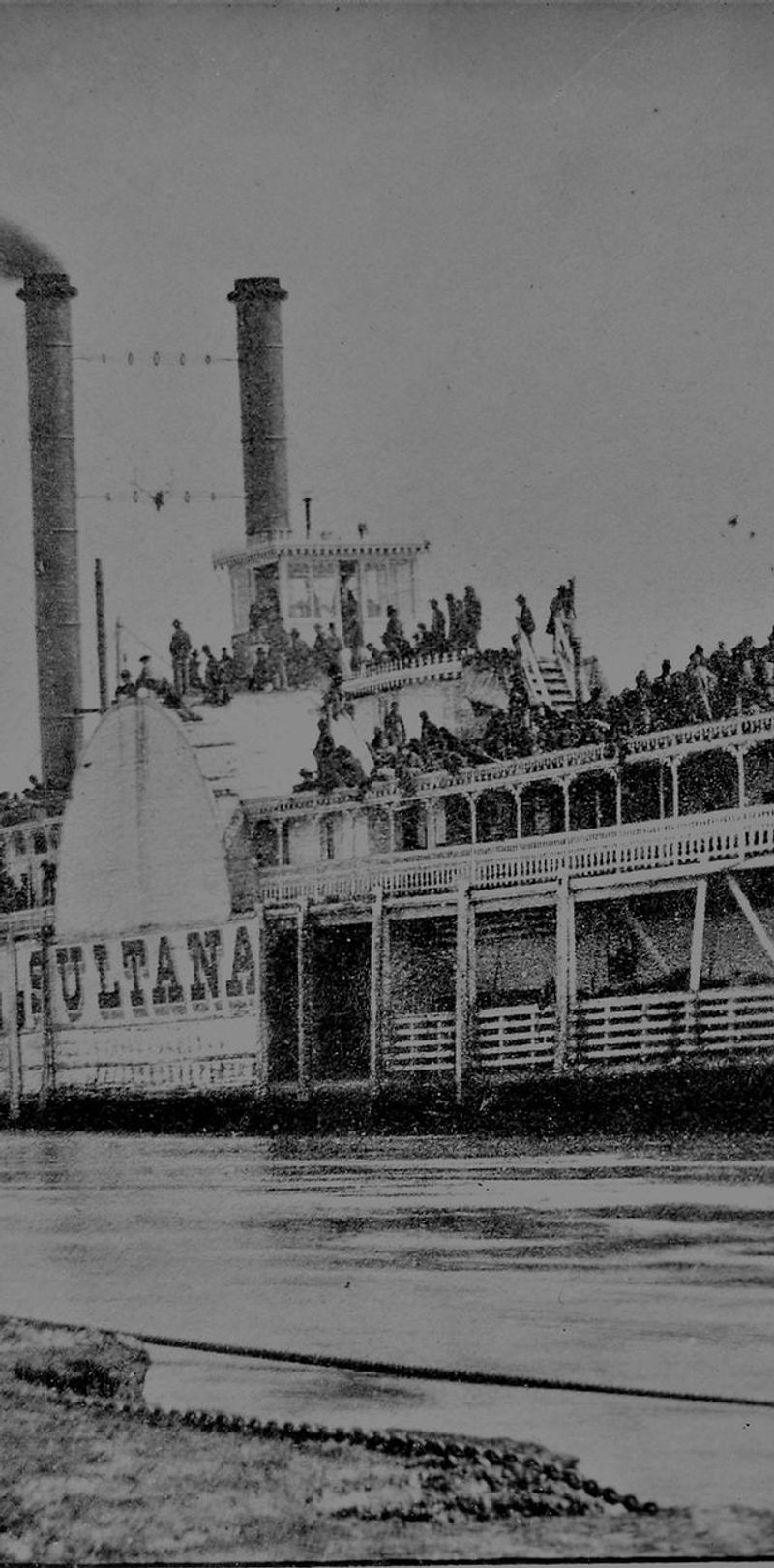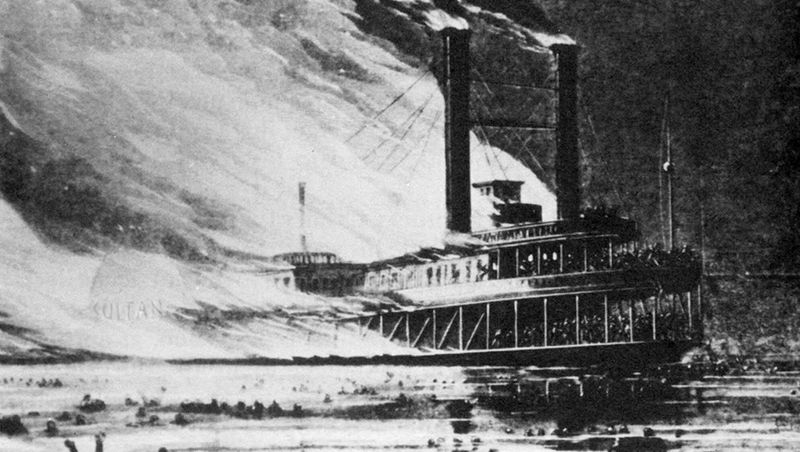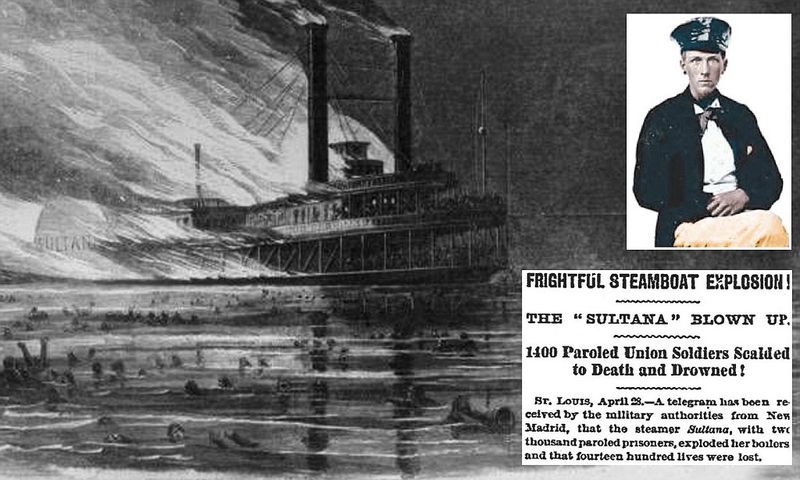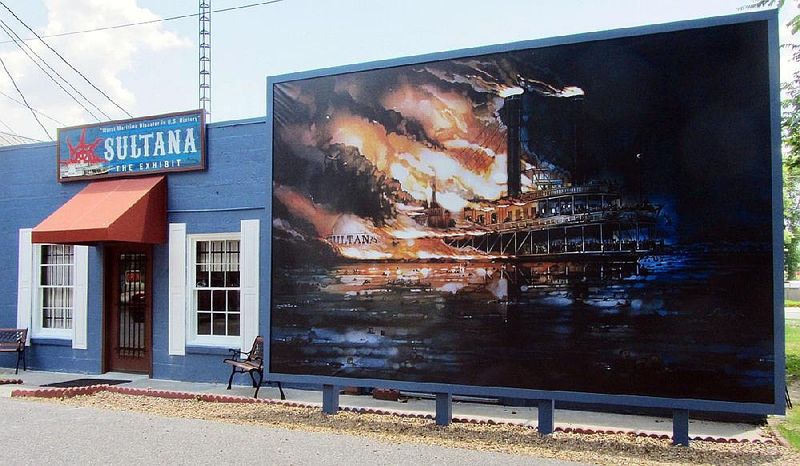In April 1865, as America celebrated the end of the Civil War, an unimaginable tragedy unfolded on the Mississippi River. The steamboat Sultana, carrying over 2,000 passengers—mostly Union soldiers returning home—exploded and sank near Memphis, Tennessee. Despite claiming more lives than the famous Titanic disaster, this catastrophic event has largely faded from our national memory. Let’s uncover the shocking truth about America’s deadliest maritime disaster.
1. Catastrophic Boiler Explosion
Around 2:00 AM on April 27, 1865, three of the Sultana’s four boilers exploded with devastating force. The blast was so powerful that passengers were thrown into the frigid Mississippi River while still in their beds.
Flaming debris rained down as the wooden vessel quickly became engulfed in flames. Survivors recalled hearing the agonizing screams of those trapped below decks or scalded by escaping steam.
Many experts believe inadequate boiler repairs combined with extreme overcrowding caused the disaster. A hasty patch job on a cracked boiler completed days earlier likely failed under the strain of powering an overloaded vessel against the Mississippi’s strong current.
2. Extreme Overcrowding Doomed the Ship
The Sultana was designed to carry a maximum of 376 passengers, but on that fateful night, over 2,000 people crowded aboard—more than five times its capacity. The deck sagged under the weight of so many bodies.
Military officials desperate to transport freed prisoners home packed the vessel beyond recognition. Men squeezed together on every available space—sleeping in stairwells, on railings, and even in the engine room.
This dangerous overloading not only contributed to the boiler failure but also made evacuation nearly impossible. With few lifeboats available and the Mississippi’s strong current, hundreds who survived the initial explosion still drowned or died from hypothermia in the cold river waters.
3. Bribery and Corruption Sealed Their Fate
Money exchanged hands behind the scenes, sealing the fate of hundreds. Captain J.C. Mason allegedly received $5 per soldier transported—a fortune in 1865—creating a financial incentive to dangerously overload the Sultana.
Government officials who should have distributed passengers among several available steamboats instead directed all soldiers to the Sultana. Historical evidence suggests Union Army Captain Frederic Speed and others accepted kickbacks for this arrangement.
The military’s chief quartermaster in Vicksburg, who controlled prisoner transport, was later found to have financial ties to the Sultana’s owners. This web of corruption prioritized profit over safety, turning what should have been a joyful journey home into America’s deadliest maritime disaster.
4. Death Toll Surpassed the Titanic
An estimated 1,800 passengers perished when the Sultana sank, making it America’s deadliest maritime disaster. This number exceeds the Titanic’s toll of 1,500 victims by hundreds of lives.
The tragedy’s scale becomes even more heartbreaking considering most victims were already survivors—Union soldiers recently released from Confederate prison camps. Many had endured months or years of brutal conditions only to die within sight of freedom.
Despite this staggering loss of life, the disaster received minimal press coverage as it occurred just days after President Lincoln’s assassination, when the nation’s attention was focused elsewhere.
5. Hasty Boiler Repairs Ignored Safety Protocols
Days before the disaster, engineers discovered a dangerous crack in one of the Sultana’s boilers while docked in Vicksburg. Rather than performing proper repairs requiring days of work, a hasty patch job was completed in just hours.
Experts later determined this temporary fix couldn’t withstand the pressure needed to power an overloaded vessel against the Mississippi’s strong current. The ship’s captain faced intense pressure to depart quickly—both to transport eager soldiers home and to maximize profits.
R.G. Taylor, the boilermaker who performed the rushed repair, later testified he had warned the repairs were inadequate for safe travel. His concerns were ignored in the rush to get the profitable human cargo moving northward.
6. Most Victims Were Already Survivors
Nearly all passengers aboard the Sultana were Union soldiers recently released from Confederate prison camps like Andersonville and Cahaba. These men had already survived the war’s worst horrors—battlefield wounds, disease, starvation, and the notorious conditions of Confederate prisons.
Many were severely malnourished and weakened by their captivity. Some could barely walk and had to be carried aboard the steamboat that would become their tomb.
The cruel irony haunts history—these resilient soldiers survived years of war and imprisonment only to perish within days of freedom. Letters found in their recovered belongings revealed many had written home just hours before the explosion, expressing joy about finally returning to their families.
7. Forgotten Disaster Overshadowed by Lincoln’s Assassination
The Sultana disaster occurred just days after President Lincoln’s assassination and during John Wilkes Booth’s manhunt. These momentous events dominated newspaper headlines nationwide, relegating America’s worst maritime disaster to back pages or brief mentions.
By the time newspapers could fully report on the Sultana, public attention had moved on. The nation, exhausted by four years of war and grief, had little emotional capacity left for another tragedy.
Historical records show some major newspapers devoted less than a paragraph to the disaster that claimed 1,800 lives. This lack of contemporary coverage helps explain why the Sultana remains relatively unknown compared to smaller disasters like the Titanic, which benefited from worldwide press attention.
8. Floating Coffin: The Mississippi’s Deadly Current
The Mississippi River became a deadly obstacle for survivors. Spring flooding had swollen the river to nearly five miles wide in some areas, with a powerful current carrying survivors miles downstream.
Water temperatures hovered around 43°F (6°C), causing hypothermia within minutes. Many who survived the initial explosion soon succumbed to the cold waters as they clung to debris.
Rescue efforts were hampered by darkness and the vast area where survivors were scattered. Some soldiers, too weak from prison camp conditions to swim, drowned immediately. Others, including strong swimmers, became entangled in submerged trees and debris hidden beneath the muddy floodwaters, creating underwater traps that claimed dozens of lives.
9. Heroic Rescue Efforts Saved Hundreds
The steamboat Bostona II, following several miles behind the Sultana, spotted the burning wreckage and immediately diverted to rescue survivors. Its crew worked tirelessly, pulling exhausted and burned passengers from the frigid waters.
Local residents along the Arkansas shore launched small boats despite the dangerous conditions. One family converted their home into a makeshift hospital, taking in dozens of injured survivors.
Cavalry soldiers from nearby Fort Pickering rode along the riverbanks with lanterns, directing rescue boats to survivors clinging to trees and debris. These combined efforts saved approximately 700 lives, though many rescued passengers later died from burns, exposure, and injuries sustained during the disaster.
10. No Justice for the Victims
Despite clear evidence of negligence and corruption, no one was ever held legally responsible for the Sultana disaster. The ship’s captain perished in the explosion, conveniently removing one potential defendant.
A military inquiry placed blame on Captain Frederic Speed, the officer who arranged the overcrowded transport. Though court-martialed, he was later acquitted when he successfully argued he was simply following orders from superiors.
The Sultana’s owners filed insurance claims and walked away financially unscathed. The government never provided significant compensation to survivors or victims’ families. This lack of accountability stands in stark contrast to modern disaster responses and represents a final injustice for those who perished.
11. The Wreck Remains Hidden Beneath Farmland
The Mississippi River changed course over the decades, leaving the Sultana’s wreckage buried beneath farmland near Marion, Arkansas. This shifting riverbed has complicated archaeological efforts to study the disaster.
In 1982, a local archaeological team claimed to locate the buried wreckage using magnetometers and ground-penetrating radar. They found the remains approximately 32 feet below a soybean field.
Recovery efforts have been limited due to the extreme depth and cost of excavation. Small artifacts occasionally surface, including personal items belonging to soldiers. The site is now recognized as historically significant, though most of the wreckage and victims’ remains continue to rest undisturbed where the river once flowed.
12. Survivors Formed a Unique Brotherhood
The approximately 700 survivors of the Sultana disaster formed a tight-knit association that met annually for reunions. These gatherings provided psychological support long before PTSD was recognized as a medical condition.
Many survivors suffered from what we now recognize as survivor’s guilt, haunted by memories of comrades they couldn’t save. Their reunion banners often read: “We survived Andersonville and the Sultana.”
The last known survivor, Private Charles M. Eldridge of the 3rd Tennessee Cavalry, died at age 96 in 1941—76 years after the disaster. His final interviews revealed he still had nightmares about the explosion and could recall the screams of drowning comrades, showing how deeply the trauma affected survivors for their entire lives.
13. Mysterious Sabotage Theories Persist
Some historians believe Confederate saboteurs may have played a role in the disaster. The war had officially ended, but pockets of resistance remained, and the Sultana carried Union soldiers who were hated symbols of the South’s defeat.
Coal with explosive materials hidden inside could have been loaded during refueling stops. Several Confederate agents were known to operate in the area, and sabotage of Union vessels had occurred previously during the war.
While most experts favor the boiler failure explanation, declassified military documents reveal intelligence reports of sabotage plots against Union transport vessels during this period. The mystery remains unsolved, adding another layer to this tragic story.
14. Families Waited Years for News
Communication in 1865 traveled slowly, leaving many families in agonizing uncertainty for weeks or months. Some families learned of their loved ones’ deaths from returning survivors rather than official notifications.
Record-keeping aboard the overcrowded vessel was chaotic, with passenger lists lost in the disaster. The Army couldn’t accurately determine who had been aboard, creating confusion about who had perished.
Some families received conflicting reports—first hearing their soldier had died, then receiving letters from hospitals claiming they were alive. A few soldiers were incorrectly listed as victims, only to appear at their own front doors weeks later. This confusion extended the grief for countless families across the Northern states.
15. Modern Recognition Finally Emerging
After more than 150 years of historical neglect, the Sultana disaster is finally receiving recognition. In 2015, a dedicated museum opened in Marion, Arkansas, featuring artifacts recovered from the wreckage and telling the stories of victims and survivors.
Documentary filmmakers have produced several works exploring the tragedy, including PBS’s “The Sultana Disaster” and the independent film “Remember the Sultana.” These projects have introduced the story to new generations.
Annual memorial services now take place near the disaster site, attended by descendants of survivors. Historians have published new research about the disaster, and educational curricula now include this significant but long-overlooked event in American history classes, ensuring these lost lives are finally remembered.
